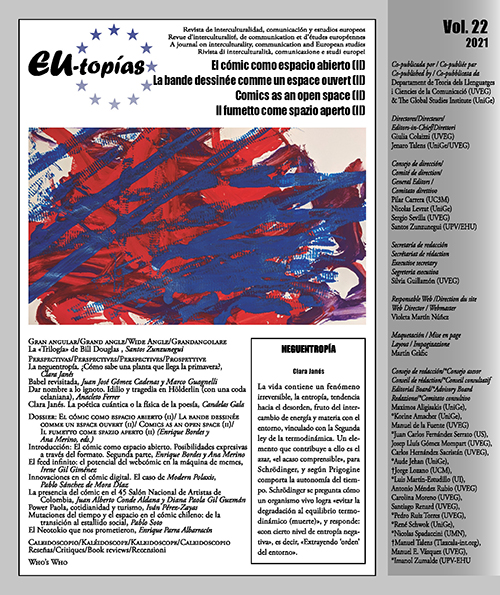The NeoTokyo that was promised
DOI:
https://doi.org/10.7203/eutopias.22.22934Keywords:
Manga, anime, Tokio, architecture, city. Abstract
Abstract
Two decades before Tokyo was elected as the host city for the 32nd Olympic Games in 2020, the manga artist Katsushiro Otomo predicted in one of his most prominent works, «Akira», that these games wouldn’t happen. After the bombings of Hiroshima and Nagasaki, mass destruction and reconstruction have influenced part of the creative line of work of many Japanese artists. Several of the most iconic Manga and Anime pieces, terms that refer to japanese comics and animation specifically, are examples of it. They recurrently focus on multiple catastrophic visions of a future Tokyo. Therefore, this article pretends to go across the streets of Japan’s capital city, analysing how the most iconic Manga and Anime artists have portrayed both its architecture and urbanism from a retro futuristic and post apocalyptic perspective.
 Downloads
Downloads
 References
References
3 Person View. Cyberpunk: Análisis de un género. 2018.
Barber, S. Ciudades proyectadas-Cine y espacio urbano. Gustavo Gili, 2006.
Bordes, Enrique. Cómic, arquitectura narrativa. Cátedra, 2017.
García Gómez, Francisco, y Gonzalo M. Pavés. Ciudades de Cine. Cátedra, 2014.
Gorostiza, Jorge. ««Metrópolis» vs. «Ghost in the Shell»». Distopía y Cine - Futuro(s) Imperfecto(s), E.P.E. Donostia Kultura, 2017.
Heredia Pitarch, Daniel. Gainax y Hideaki Anno - La historia de los creadores de Evangelion. Diabolo Ediciones, 2019.
Hernández Pérez, Manuel. Manga, anime y videojuegos - Narrativa cross-media japonesa. Prensas de la Universidad de Zaragoza, 2017.
Hideaki, Anno. Neon Genesis Evangelion. 1995.
Katsushiro, Otomo. Akira. 2019.a ed., Norma Editorial, 1984.
Katsushiro, Otomo. Akira. Toho, 1988.
Kishiro, Yukito. Gunnm - Battle Angel Alita. Belles Lettres, 2017.
Lammare, Thomas. «Born of Trauma: Akira and Capitalist Modes of Destruction». Positions: East Asia Cultures Critique, 2008.
Lus Arana, Luis Miguel. Futurópolis: el cómic y la construcción transmedia de la ciudad futura. Universidad de Navarra, 2013.
Masamune, Shirow. The Ghost in the Shell. 2017.a ed., Planeta Cómic, 1991.
Mur Vicente, Sergio. Anime y Cyberpunk: Visiones del Japón moderno en la serie Ghost in the Shell. Universidad de Zaragoza, 2019
Napier, Susan J. Anime from Akira to Howl’s Moving Castle: Experiencing Contemporany Japanese Animation. Palgrave Macmilla, 2006.
Napier, Susan J. «The Japanese Imagination of Disaster from godzilla to Akira». Journal of Japanese Studies, 1993, pp. 327-51.
Nihei, Tsutomu. Blame! Panini España, 2017.
Oshii, Mamoru. Ghost in the Shell. Manga Entertainment, 1995.
Palacios, Jesus. Conferencia Online «CIBERJAPON: futurismo, ciencia ficción y distopía en el anime». 2020.
Quetzal. Ánalisis de «Ghost in the Shell». 2017.
Riekeles, Stefan. Anime Architecture. Thames and Hudson Ltd, 2020.
Sadamoto, Yoshiyuki. Neon Genesis Evangelion. Norma Editorial, 2005.
Serrano García, Valentín. «Las ciudades imaginarias - Sueños entre las nubes y las cenizas». Ciudades de Cine, Cátedra, 2014.
VVAA. Neon Genesis Evangelion - Tv animation Production Art Collection. UDON Entertainment Inc., 2019.
Downloads
Published
How to Cite
-
Abstract333
-
PDF (Español)244
Issue
Section
License
![]()
The authors conserve the copyright. All content published in EU-topías. Journal of interculturality, Communication, and European Studies are subject to the license Creative Commons Attribution-NonCommercial-ShareAlike 4.0 license. The full text of the license can be found at <http://creativecommons.org/licenses/by-nc-sa/4.0>
They may be copied, used, disseminated, transmitted and publicly displayed, provided that:
- The authorship and original source of the publication is cited (journal, publisher and URL of the work).
- They are not used for commercial purposes.
- The existence and specifications of this license of use are mentioned.
It is the responsibility of the authors to obtain the necessary permissions for images that are subject to copyright.



